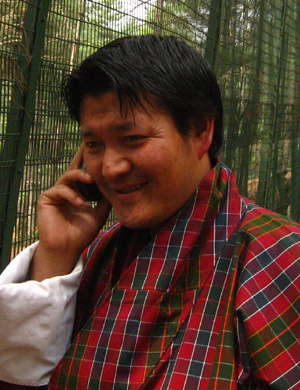
Gyem Dorgi, our Bhutanese guide and devoted Buddhist practitioner, became a friend and trusted companion in the two weeks we were with him. One of my favorite memories of Gyem, is him dressing me in a “Gho,” the traditional Bhutanese man’s outfit, which he wore every day with ease and grace. In the late afternoon of our second day in Bhutan we walked to his favorite (locals only) Gho shop, just down the street from his wife’s kitchen utensil and appliance store. I pawed my way through dozens of one-size-fits-all Ghos, until I found a formal, finely woven, all black, woolen Gho, with a sky blue lining and deep red border. After we picked out the removable, nine inch white cuffs, theoptional white collar, a multicolored hand woven belt, and black socks, I carried my 12 pound bundle of clothes back to the hotel for the first of three training sessions with Gyem. He approached these training sessions with the same patience, grace, compassion, love, and humor with which he approached everything in life.
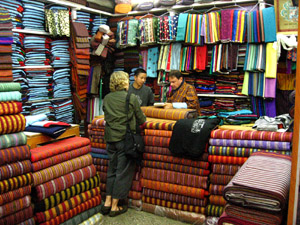
We were invited to a “formal” dinner that evening, so it was a chance to try out the new duds. A Gho is a one-piece outfit that vaguely resembles a long sleeved, knee length tunic with long white cuffs and knee socks. When Gyem helped me get my arms through the sleeves (not an easy task), I found I was wearing a toasty warm, floor length monk’s robe. It was early spring in the Himalayan foothills, so I was glad of the warmth. The process of turning a monk’s robe into a formal piece of Bhutanese clothing would have been comical if it didn’t take such concentration. Each fold has to be measured exactly, held, tucked and refolded on both sides, 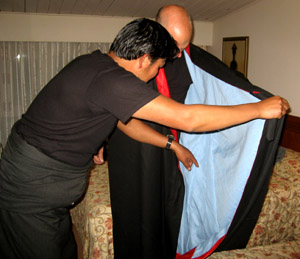 then once again held with both hands while the belt is wrapped around three times so nothing slips. Gyem assured me that he can dress himself each morning without help. I have no idea how he does it. Even with four hands, it’s a challenge. If the folds or belt do slip at all, the elegance turns to embarrassment. The cost of no slippage is an extraordinarily tight belt. That first night, the belt was so tight I could barely sit down in a chair, let alone eat. I didn’t know how tight was tight enough, so I was afraid to loosen it.
then once again held with both hands while the belt is wrapped around three times so nothing slips. Gyem assured me that he can dress himself each morning without help. I have no idea how he does it. Even with four hands, it’s a challenge. If the folds or belt do slip at all, the elegance turns to embarrassment. The cost of no slippage is an extraordinarily tight belt. That first night, the belt was so tight I could barely sit down in a chair, let alone eat. I didn’t know how tight was tight enough, so I was afraid to loosen it.
The next day I wore the Gho again and asked Gyem to put the belt on more loosely. This time it was considerably more comfortable. A couple hours later, all the folds came apart, and I had to be dressed again, almost from the “get-Gho,” while standing outside the gates of a temple. 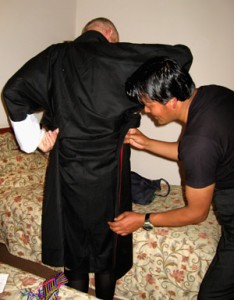 The third Gho session brought success, complete with photo documentation. Our lengthy session of Gho on, Gho off, Gho on, Gho off, made us fifteen minutes late for our farewell dinner, and taught me the Gho-For-Dummies basics, which I might be able to duplicate if I had six arms.
The third Gho session brought success, complete with photo documentation. Our lengthy session of Gho on, Gho off, Gho on, Gho off, made us fifteen minutes late for our farewell dinner, and taught me the Gho-For-Dummies basics, which I might be able to duplicate if I had six arms.
This evening I was as comfortable in the Gho as I have been in anything I have ever worn. I felt relaxed, elegant and utterly at home. It was as if I were both monk and nobleman. I hope I will be able to wear it back home with such ease. Perhaps with a few strategically placed strips of Velcro, I’ll be able to pull it off. Check me out at our next winter party!
Every Asian country I have been in is full of motorbikes. Not so in Bhutan. Last week Gyem told me a story about buying a motor cycle and selling it two months later. When I asked him why, he simply said, “It was cold.” He didn’t elaborate. The fact that motorbikes are rare in Bhutan was something I understood once I put on the Gho that first evening and realized how cold it would be riding around at 10,000′ on a motorcycle, legs astride, wearing, for all practical purposes, a skirt. I don’t know what the Scotts wear under their kilts, but it probably isn’t nothing, but also not much more than jockey shorts.
Gyem went through grade twelve, and was ready to start university in India when his plans collapsed because of financial concerns. The resources simply weren’t there. His father, now a farmer and a highly respected lay monk, was sent to a monastery in Tibet at age six, and remained there until China smashed the Tibetan rebellion in 1959. He was forced to flee for his life, back to Bhutan. During his last years in Tibet, he and fellow monks lived in caves in the high Himalayas, meditating and reading scriptures. They were snow bound in the winter and spent a month or two in the fall begging for enough food to take back to the caves to last through the winter. Most other monks had some degree of family support, but being from a poor Bhutanese family, no help was possible for him. At night, he read scriptures by the light of burning incense. Sometime after his return to Bhutan, he chose to become a lay monk and have a family, which is lucky for the rest of us who have come to know, appreciate, and care for his son, Gyem.
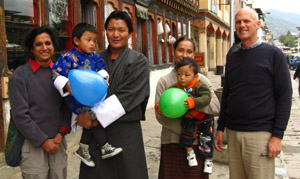
The love of the Buddhist teaching was passed on to Gyem by his father. I think Gyem would have been happy to be a monk. His face shines when he talks about that kind of life and his own meditation. He happily explains in detail, each step of his early morning hour of prayer. The prayers to each God and Goddess, Buddha and saint are explained with reverence. What prayer is offered, how long each part takes, and why it is done, is gently revealed with passion and self depreciating humor. We did have the opportunity to meet Gyem’s wife and two little gems, as he calls them. I suspect she has her hands more than full, with the three of them.
Never in the fifteen days that we traveled with him, was there a hint of impatience or stress on his face or in his voice. The gentle strength and compassion that Gyem possesses in full measure, is a wonderful presence.
We are missing him terribly today, as we navigate our way through the noisy, crazy, polluted, and traffic choked city of Kathmandu. Bhutan is a tough act to follow. So is Gyem.